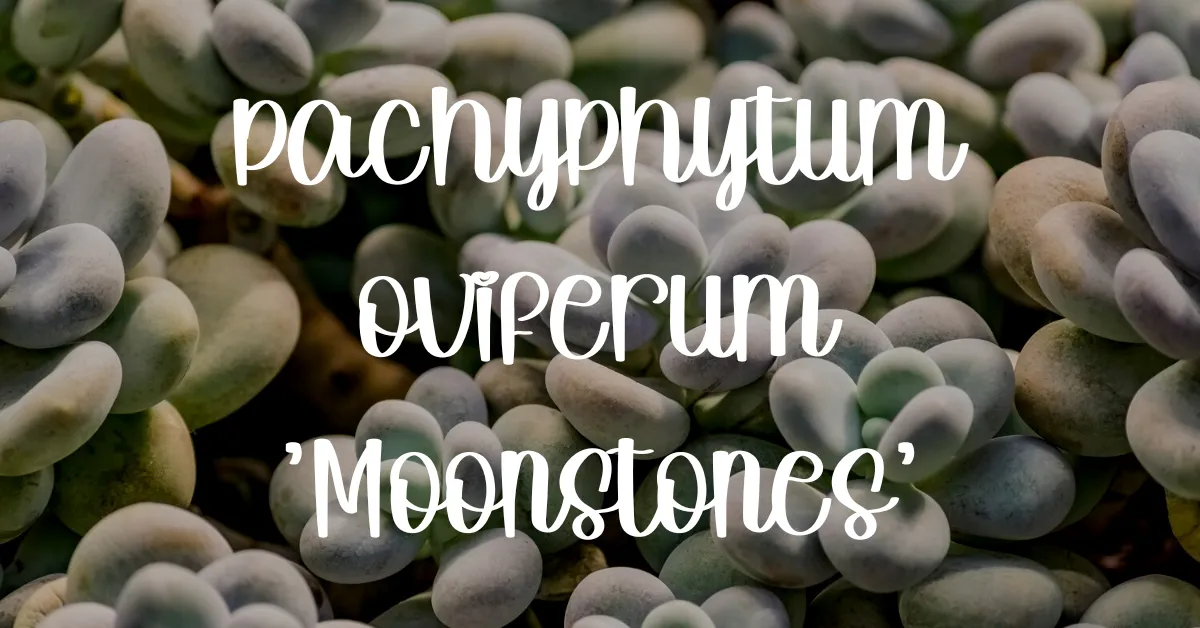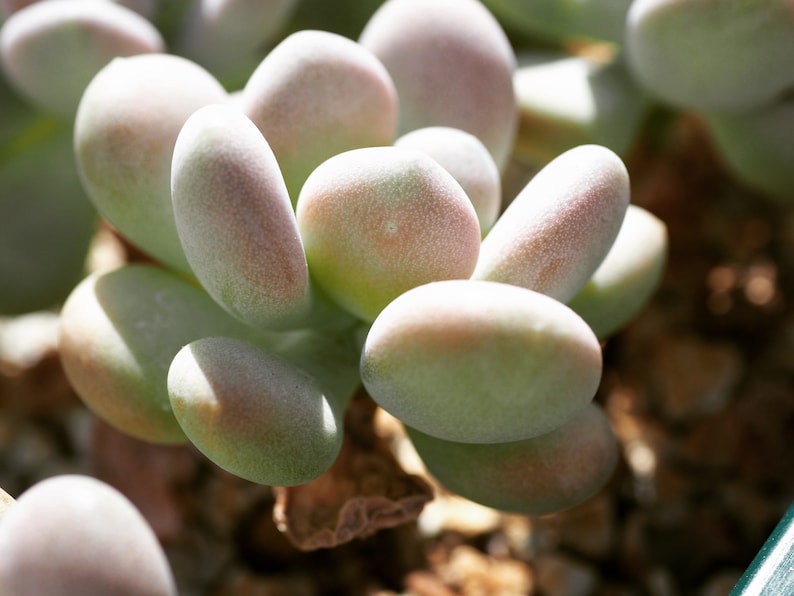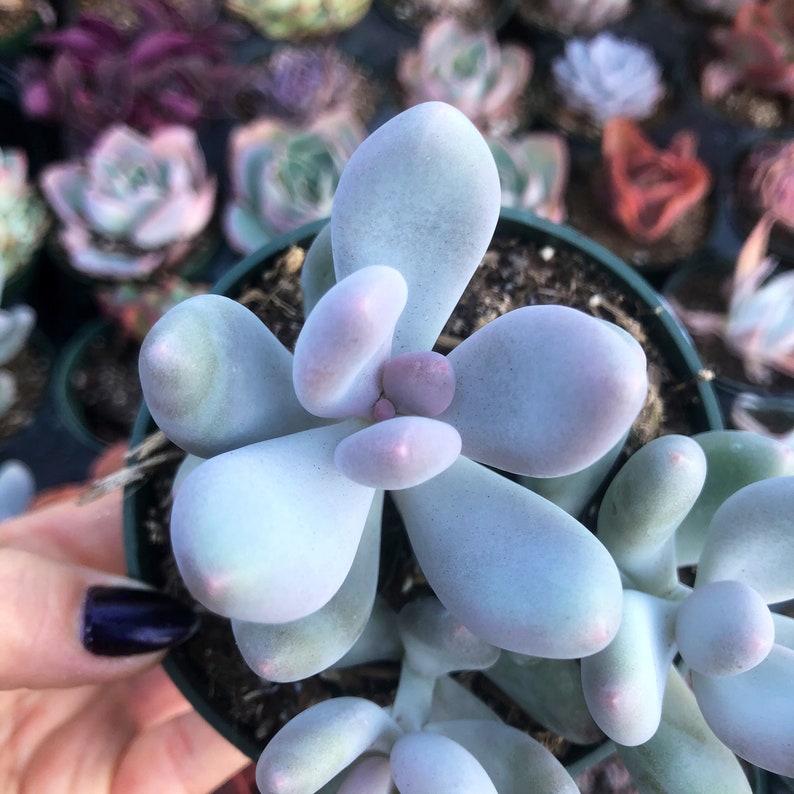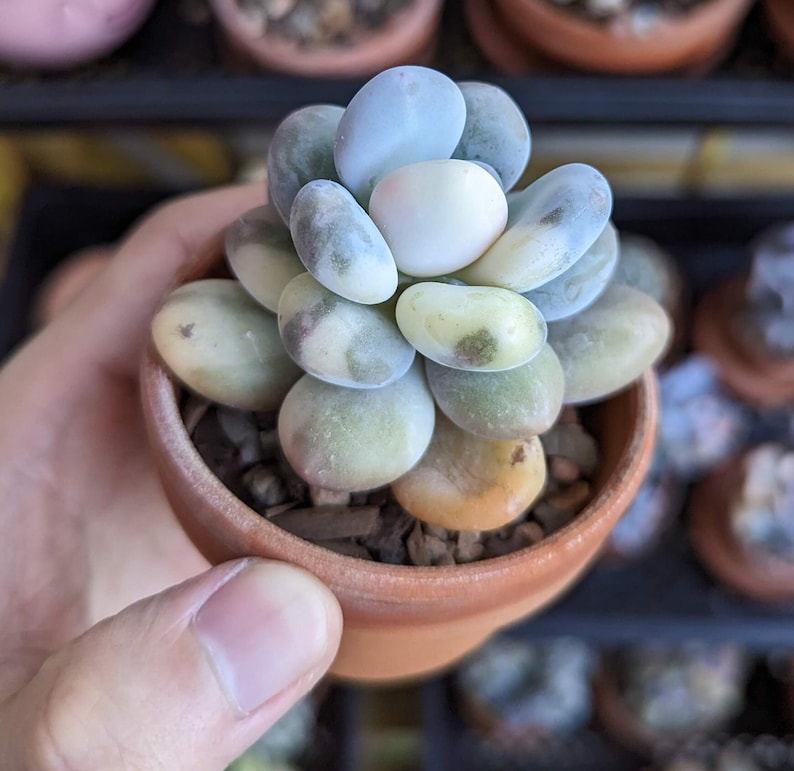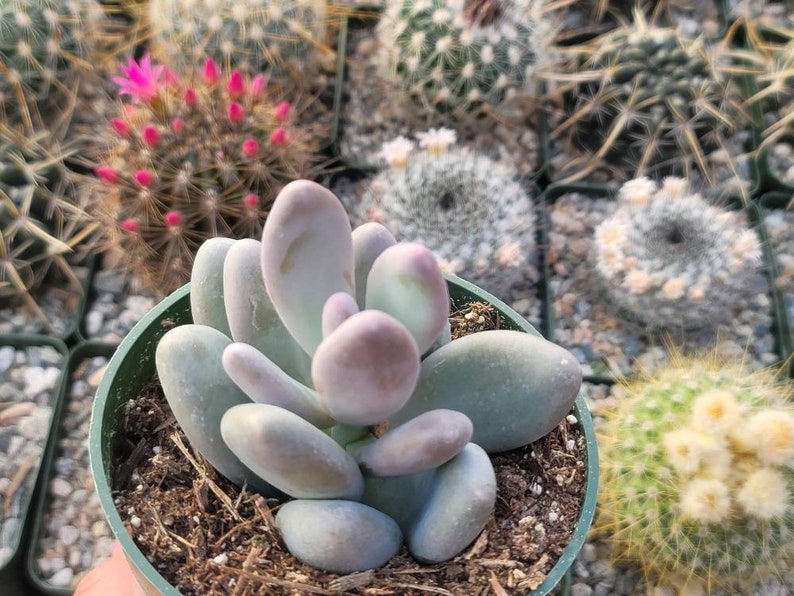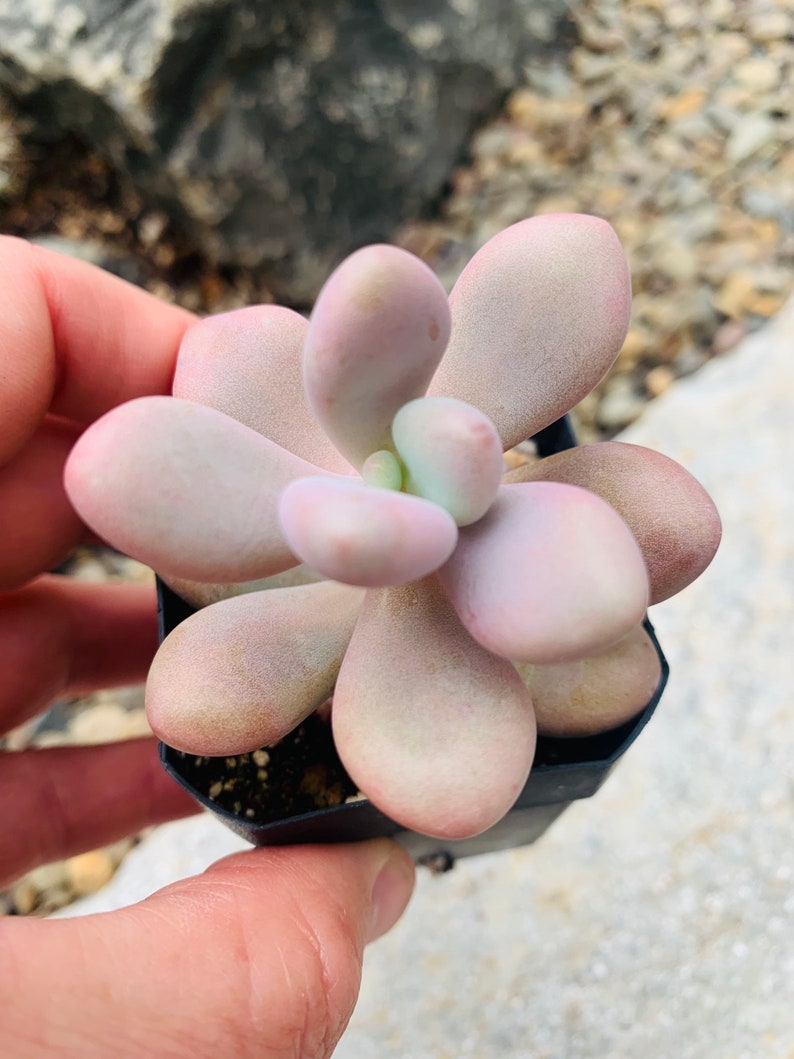Pachyphytum oviferum, also known as ‘Moonstone Succulent’ or Sugar Almonds, is a type of succulent plant known for its unique, chubby leaves and pastel-colored flowers. Native to Mexico, Pachyphytum oviferum is a popular choice for gardeners and plant enthusiasts due to its easy care requirements and striking appearance.

Pachyphytum oviferum ‘Moonstone Succulent’ is a succulent that produces distinctive egg-shaped leaves. It has the following characteristics:
• Thick, egg-shaped leaves that are blue-green to pale green in color. The leaves grow in pairs opposite each other along the stem.
• A branching stem structure that produces new leaf pairs as it grows. The stem may trail or hang down over the sides of the pot.
• Showy pink or purple flowers that emerge on a tall flower stalk. The flowers have six petals and nine stamens. Flowers only appear on mature plants with strong light and during the growing season.
• A slow-growing habit. Pachyphytum oviferum grows relatively slowly, only producing a few new leaf pairs each year. This makes it suitable as a houseplant since it will not outgrow containers quickly.
With its unusual foliage and trailing stems, Pachyphytum oviferum is an attractive succulent that thrives with bright light and minimal water. Its slow growth and propagation from leaves make this an ideal houseplant for succulent collections. With the right conditions, Pachyphytum oviferum ‘Moonstone Succulent’ will produce fascinating egg-shaped leaves and colorful flowers.
In this post, we will explore the care requirements for Pachyphytum oviferum and provide some tips for keeping this plant healthy and happy.

What is Pachyphytum oviferum?
Pachyphytum oviferum is a type of succulent plant that is native to Mexico. It is a member of the Crassulaceae family and is known for its chubby, pink leaves and pastel-colored flowers. These flowers are typically pink or purple and appear on tall stems during the spring and summer months. Moonstone succulents are a popular choice for gardeners and plant enthusiasts due to its unique appearance and easy care requirements.
Important Info for All: Drainage Hole at the Bottom of The Pot: Do Succulents Need Them? The Answer Might Completely Shock You!


Everything you need to know about: Root Rot in Succulents: How to Identify and Treat the Problem
How to Care for Pachyphytum oviferum
Pachyphytum oviferum ‘Moonstone Succulent’ is a relatively easy plant to care for, making it a great choice for beginners and experienced gardeners alike. Here are some tips for keeping this plant happy and healthy:

Light
Pachyphytum oviferum ‘Moonstone Succulent’ is generally pest and disease-resistant. However, overwatering can cause root rot, while underwatering can cause the leaves to shrivel and turn brown. If you notice any pests, use a mild soap and water solution to remove them.
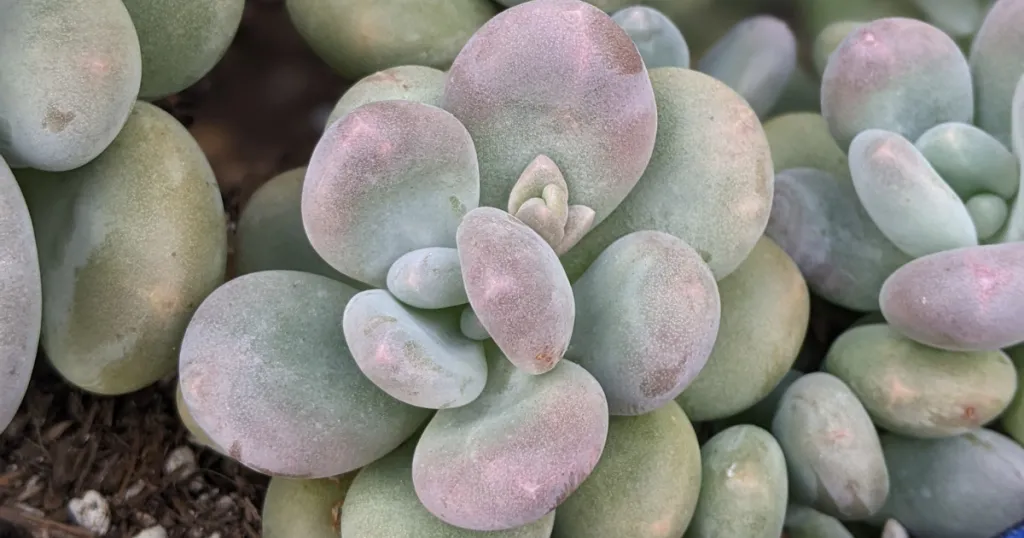
Another common problem with Pachyphytum oviferum ‘Moonstone Succulent’ is sunburn. This plant prefers bright, indirect sunlight, but too much direct sunlight can scorch its leaves, causing them to turn brown or yellow. If you notice sunburn on Pachyphytum oviferum, move it to a shadier spot and gradually introduce it to more sunlight over time.
You might also like: 5 Essential Mental Health Benefits of Gardening Succulents and Cacti
Another issue that can affect Pachyphytum oviferum ‘Moonstone Succulent’ is etiolation, which occurs when the plant doesn’t receive enough light and stretches out towards the light source. To prevent etiolation, make sure to place your plant in a spot where it can receive sufficient light.
How to Water Pachyphytum oviferum ‘Moonstone Succulent’
Pachyphytum oviferum ‘Moonstone Succulent’ is an excellent option for people who may forget to water their plants frequently because it is drought-tolerant and can thrive in dry conditions. However, it is still important to water it regularly to keep it healthy. When watering, it is crucial to give the plant a deep and thorough soak to allow the water to reach the roots of the plant. This helps to ensure that the plant is getting the necessary moisture it needs to survive.
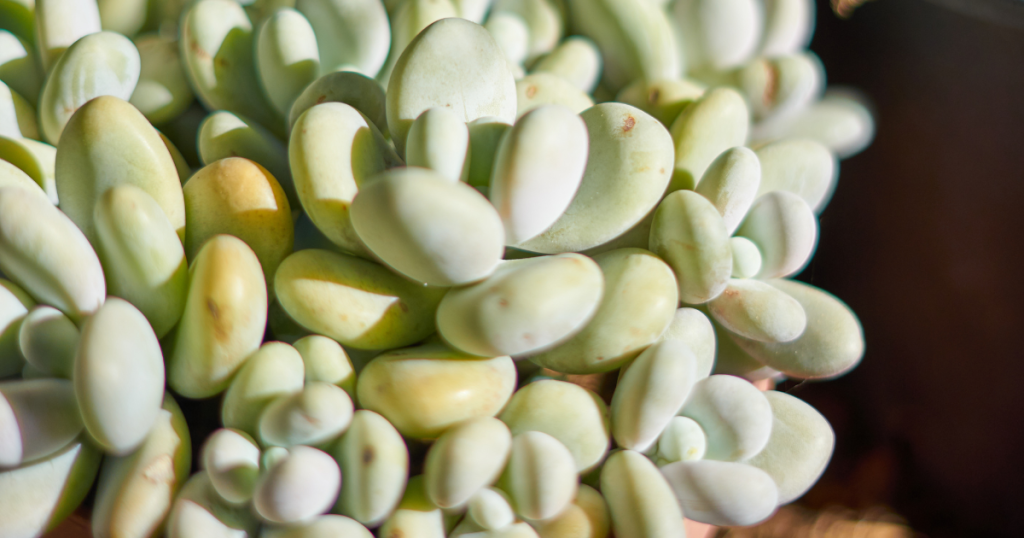
It is important to let the soil dry out completely between watering to avoid overwatering, which is one of the most common issues that succulent owners face. Overwatering can cause the roots of Pachyphytum oviferum to rot, which can ultimately lead to the plant’s death. To prevent this, it is essential to check the soil’s moisture level before watering and wait until it is completely dry before watering again.
You might also like: Root Rot in Succulents: How to Identify and Treat the Problem
During the winter months or in cooler temperatures, Pachyphytum oviferum ‘Moonstone Succulent’ requires less frequent watering as the plant goes into dormancy. This means that the plant’s growth slows down, and it requires less water to survive. In contrast, during the summer months or in warmer temperatures, the plant may require more frequent watering to keep up with its growth rate.
Should I adjust my watering schedule if my Pachyphytum oviferum ‘Moonstone Succulent’ is in a low-light area?
Yes, it is a good idea to adjust your watering schedule for Pachyphytum oviferum based on lighting conditions. Here are some guidelines:
• In lower light, the soil will dry out more slowly. Therefore, you should increase the time between waterings and be very careful not to overwater the plant. Only water when the soil is quite dry to the touch. It may only need water every 10-14 days in low light.
• As with brighter light conditions, water thoroughly but not too frequently when the soil is dry. Provide enough water for it to flow out the drainage holes, then let the soil dry again before the next drink.
• Watch for signs of overwatering closely in low light, since excess moisture will be harder for the plant to counteract. Leaf drop, wilting, mold or mildew, and slowed growth can all be signs you are watering too often. Scale back your watering schedule if you notice these issues.
• If possible, provide more light for your Pachyphytum oviferum. Additional light will lead to faster growth and more frequent watering, but the increased illumination is important for this succulent to thrive. Use a grow light or move the plant to a brighter spot in your home if you can.
Adjusting your watering approach based on lighting conditions will help ensure your Pachyphytum oviferum gets the moisture it needs without risk of overwatering. With attention, this fascinating succulent can do well in a range of light levels when its water needs are met appropriately.
Soil for Pachyphytum oviferum ‘Moonstone Succulent’
Good soil is crucial for the health and well-being of Pachyphytum oviferum ‘Moonstone Succulent’. This succulent prefers soil that is porous, well-draining, and nutrient-rich. Using a soil mix that is specifically formulated for cacti and succulents is ideal, as it is specifically designed to provide the excellent drainage that this plant needs to thrive.
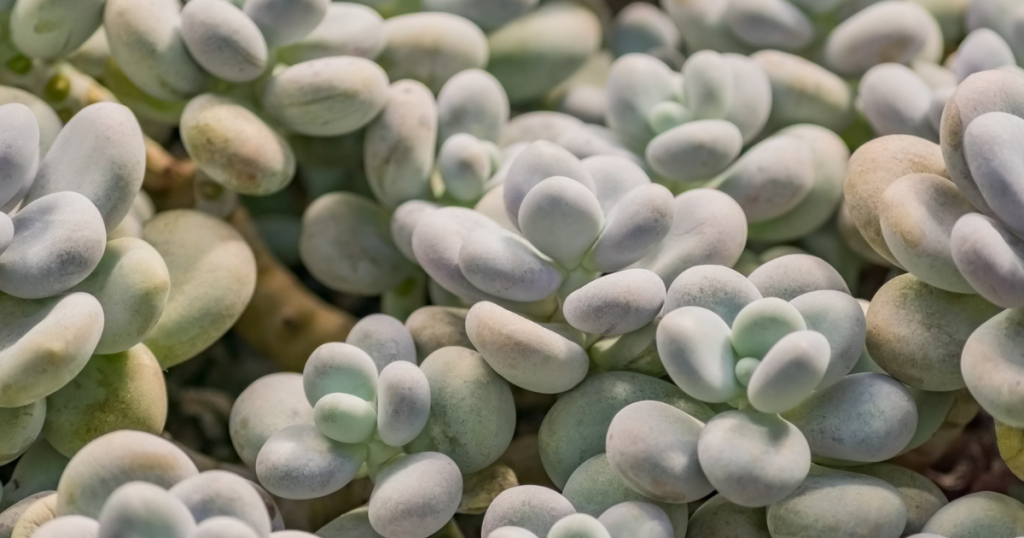
A good soil mix can be made by combining cactus soil, pumice, Turface and perlite in equal parts. Perlite is a lightweight, porous volcanic rock that helps to create air pockets in the soil, which aids in water drainage and aeration. This mixture allows the soil to retain moisture while still allowing excess water to drain away, preventing overwatering and root rot.
You might also like: Succulent Dormancy: How to Care for Your Plant Even When They Look Dead or Dying
In addition to using the proper soil mix, it is also essential to choose the right pot for your Pachyphytum oviferum ‘Moonstone Succulent’. The ideal pot should have drainage holes to allow excess water to flow out of the soil. This will prevent the soil from becoming waterlogged and help to maintain the proper moisture levels for Pachyphytum oviferum.
Fertilizer
Pachyphytum oviferum ‘Moonstone Succulent’ does not typically require fertilizer. However, if you want to give your plant a boost, you can fertilize it once a month during the growing season (spring and summer) using a balanced fertilizer diluted to half strength.

Succulent fertilizer available to purchase on Etsy.
How to propagate Pachyphytum oviferum ‘Moonstone Succulent’
Propagation is one of the most exciting aspects of caring for succulents, and Pachyphytum oviferum ‘Moonstone Succulent’ is no exception. Propagating these plants is straightforward and rewarding, making it an excellent option for new and experienced gardeners alike.
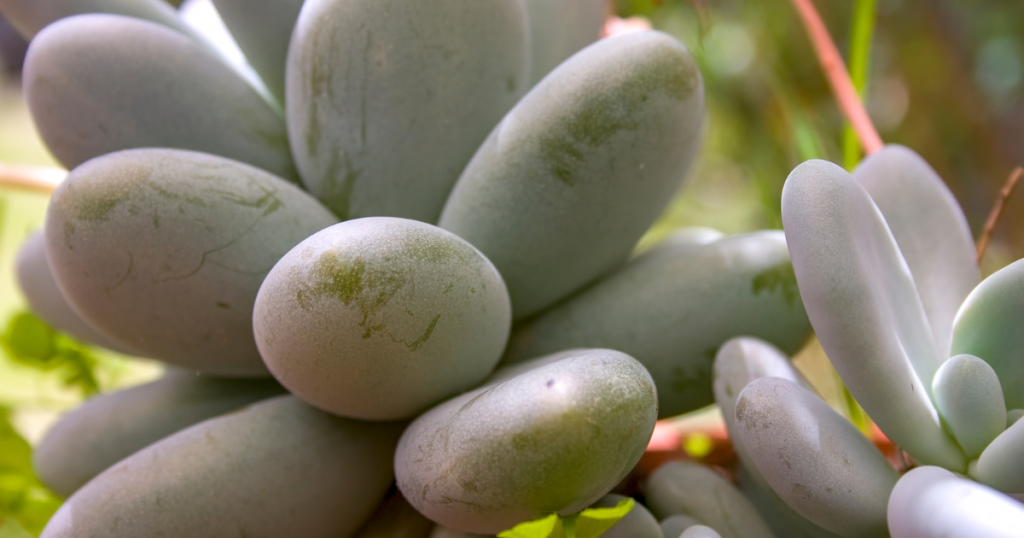
To propagate Pachyphytum oviferum ‘Moonstone Succulent’, begin by taking a stem cutting from a mature plant. Use a clean, sharp pair of scissors or pruning shears to cut a section of the stem about 2-3 inches long. Allow the cutting to dry for several days in a shaded and dry area to form a callus before planting it.
You might also like: Why You Shouldn’t Plant Succulents in Terrariums: The Risks and Consequences
When your Pachyphytum oviferum ‘Moonstone Succulent’ cutting has formed a callus, it is time to plant it. Fill a small pot with well-draining soil, such as a cactus or succulent mix. Make a small hole in the soil, and gently place the stem cutting inside. Be careful not to bury it too deep, or it may rot.
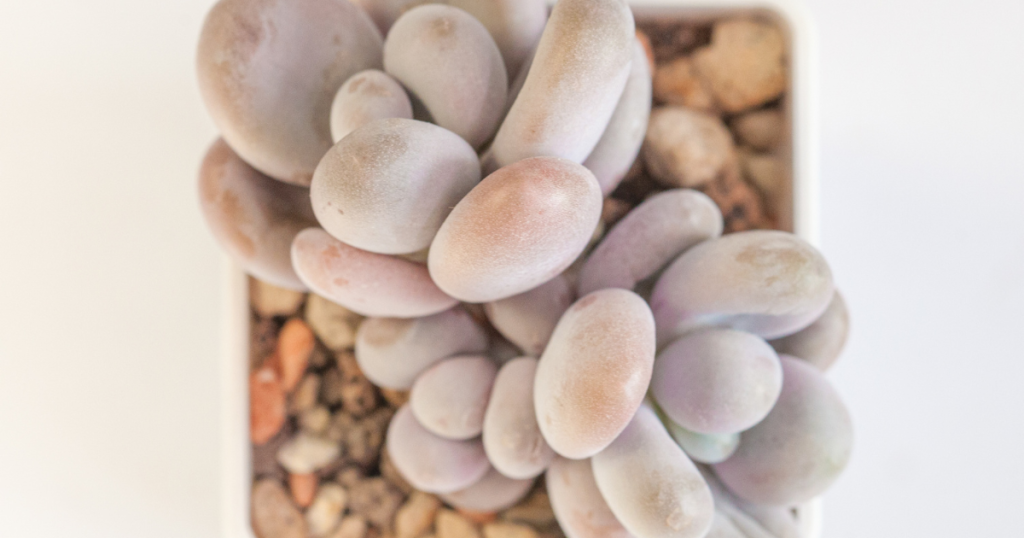
After planting, water the Pachyphytum oviferum ‘Moonstone Succulent’ cutting sparingly. You want to keep the soil moist but not soaked. As your new plant begins to grow, it will develop roots and start to thrive. Once Pachyphytum oviferum gets closer to full size, keep the soil dry in between waterings as overwatering is the most common reason succulents die.
You might also like: The Fascinating World of Powdery Farina: Understanding 3 Ways the White Powder on Succulent Leaves Protects Them
Pachyphytum oviferum ‘Moonstone Succulent’ Hardiness & Temperature
Pachyphytum oviferum ‘Moonstone Succulent’ can only withstand temperatures above 30°F, making it a warm-weather plant. If you live in an area with colder temperatures during the winter, it’s best to keep this plant indoors or in a greenhouse to protect it from the cold.
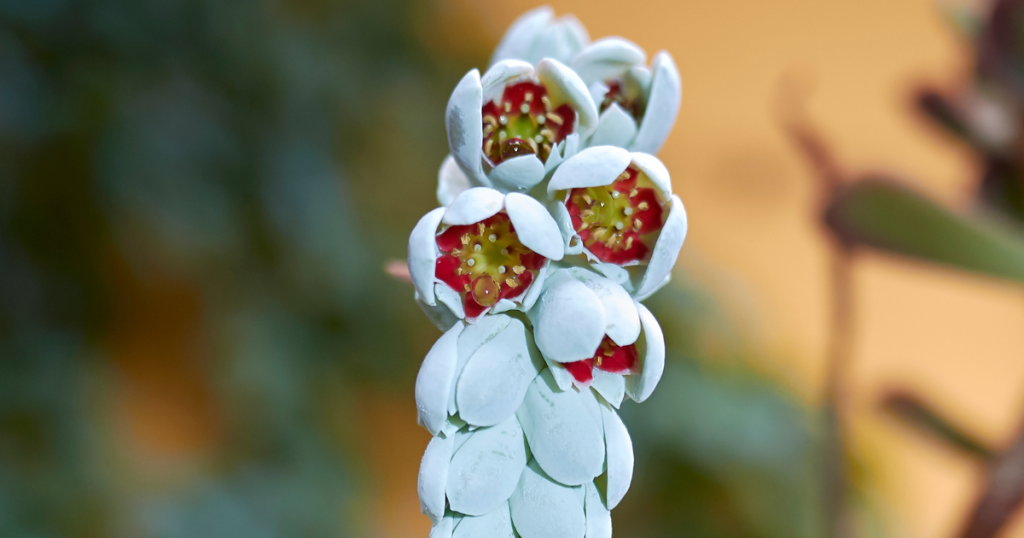
During the warmer months, Pachyphytum oviferum ‘Moonstone Succulent’ prefers temperatures between 70-80°F. In hotter climates, it may benefit from some afternoon shade to prevent the leaves from burning. It’s also important to avoid placing the plant near drafty areas, such as air conditioning vents or open windows, as this can cause the plant to dry out too quickly. With proper temperature and environment, your ‘Moonstone Succulent’ can thrive and produce stunning, unique leaves.
You might also like: Taking Care of Succulents Inside

Pachyphytum oviferum is a stunning succulent plant that is sure to add a touch of beauty to your collection. With its unique, chubby leaves and pastel-colored flowers, it’s a great choice for gardeners of all levels. By providing it with bright, indirect light, watering it properly, and using a well-draining soil mix, you can help ensure that yours stays healthy and happy for years to come.
Can’t Miss: Euphorbia alluaudii ‘Madagascan Fire Plant’: A Comprehensive Care Guide

You might like: Echeveria desmetiana: A Comprehensive Guide to This Classic Beauty

You might also like: Succulent Death Bloom (Sounds like a metal band.)


Where to Buy Succulents Online

